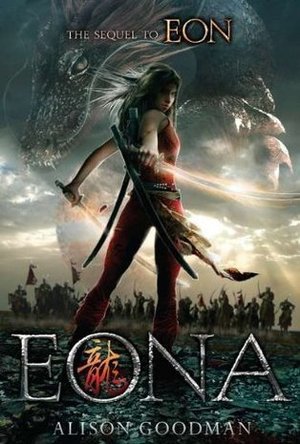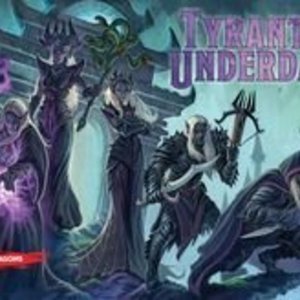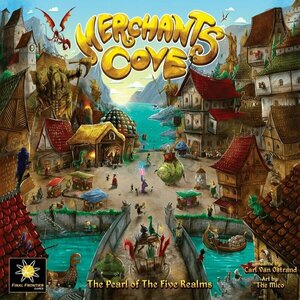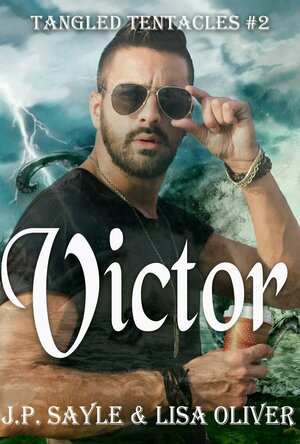Search
Search results
Sophia (Bookwyrming Thoughts) (530 KP) rated Eona: The Last Dragoneye (Eon, #2) in Books
Jan 23, 2020
Apparently when Eona and Co. are on the run, things get mighty interesting and there's almost never a dull moment. There's the ten dead Dragoneyes, an entire army of Sethon's supposed minions (who knows if they're actually loyal to the dude, anyways?), and a supposed-to-be emperor by the name of Kygo who's also on the run from being brutally murdered as well.
Goodman starts out the whopping 600-paged book with a "primary" source from Teacher Prahn, quickly summarizing the events at the imperial palace in the ending of Eon, and it's helpful for those who haven't the first book in a long while (unless you have a fantastic memory, which I sometimes have. Epiphany!). The second and last book to the duology starts out shortly after those events, with Eona and her friends on the run from Sethon and the hunt for Kygo. Goodman brings us outside of the imperial palace and into other parts of the Empire of Celestial Dragons, places that were briefly mentioned in book one and now play a bigger role in book two.
I personally disliked Eona back when she was Eon, and I don't like her any better as a girl either. Back as Eon, Eona just seemed to desperate to fit in and trying to prove herself worthy – those sun drug scenes? The worst of Eon. I even vowed to DNF this book if Eona decided to run around with the sun drug again; it was that bad.
In a way, I do like Eona: she's not desperate, she's <s>Taylor Swift</s> fearless (all those odds stacked against her!) – she's a lot better when compared to Eon, when she trying to fully disguise herself as a guy and being a slinky. Eona just argues a lot with Kygo when she finally finds him, and I mean a huge emphasis on "argues a lot." I'm pretty sure if I get a dollar for every time they argued, I could actually pay my rent. Though compared to the <s>lovely</s> love triangle with Ido (thank you, so-called prophecy), I fully ship Kygo and Eona, even though Eona seems very mopey when it comes to whether or not Kygo truly loves her.
<blockquote>"What if I said you could have either me or my power? Which one would you choose?"</blockquote>
Eona certainly makes up for the many dull moments in pacing from its predecessor, where the beginning is a little interesting, the middle is extremely draggy and the decent ending is very fast and rapid. The pacing in the final book of Goodman's Eon duology is much better and engrossing, bringing us a fantastic end to two very long books.
-----------------
Original Rating: 4.5 out of 5
Review originally posted at <a href="http://bookwyrming-thoughts.blogspot.com/2015/01/review-eona-by-alison-goodman.html">Bookwyrming Thoughts</a>
<a href="http://bookwyrming-thoughts.blogspot.com/"><img src="http://3.bp.blogspot.com/-cG5gfBqJVzk/VA5BIojjZ9I/AAAAAAAAD1g/7srLUfpAGEU/s1600/banner.png"; /></a>
Goodman starts out the whopping 600-paged book with a "primary" source from Teacher Prahn, quickly summarizing the events at the imperial palace in the ending of Eon, and it's helpful for those who haven't the first book in a long while (unless you have a fantastic memory, which I sometimes have. Epiphany!). The second and last book to the duology starts out shortly after those events, with Eona and her friends on the run from Sethon and the hunt for Kygo. Goodman brings us outside of the imperial palace and into other parts of the Empire of Celestial Dragons, places that were briefly mentioned in book one and now play a bigger role in book two.
I personally disliked Eona back when she was Eon, and I don't like her any better as a girl either. Back as Eon, Eona just seemed to desperate to fit in and trying to prove herself worthy – those sun drug scenes? The worst of Eon. I even vowed to DNF this book if Eona decided to run around with the sun drug again; it was that bad.
In a way, I do like Eona: she's not desperate, she's <s>Taylor Swift</s> fearless (all those odds stacked against her!) – she's a lot better when compared to Eon, when she trying to fully disguise herself as a guy and being a slinky. Eona just argues a lot with Kygo when she finally finds him, and I mean a huge emphasis on "argues a lot." I'm pretty sure if I get a dollar for every time they argued, I could actually pay my rent. Though compared to the <s>lovely</s> love triangle with Ido (thank you, so-called prophecy), I fully ship Kygo and Eona, even though Eona seems very mopey when it comes to whether or not Kygo truly loves her.
<blockquote>"What if I said you could have either me or my power? Which one would you choose?"</blockquote>
Eona certainly makes up for the many dull moments in pacing from its predecessor, where the beginning is a little interesting, the middle is extremely draggy and the decent ending is very fast and rapid. The pacing in the final book of Goodman's Eon duology is much better and engrossing, bringing us a fantastic end to two very long books.
-----------------
Original Rating: 4.5 out of 5
Review originally posted at <a href="http://bookwyrming-thoughts.blogspot.com/2015/01/review-eona-by-alison-goodman.html">Bookwyrming Thoughts</a>
<a href="http://bookwyrming-thoughts.blogspot.com/"><img src="http://3.bp.blogspot.com/-cG5gfBqJVzk/VA5BIojjZ9I/AAAAAAAAD1g/7srLUfpAGEU/s1600/banner.png"; /></a>
Russell Evans (179 KP) rated Tyrants of the Underdark in Tabletop Games
Feb 24, 2020 (Updated Feb 24, 2020)
Interesting deck building mechanics (3 more)
Several different viable strategic options
Quick paced, easy to learn to play
Great artwork on cards
A quick paced game of fantasy deck building strategy, skilfully mixed with area control
This game mixes up a couple of game genres, but it balances them really well. I brought this game as my teenage son is a D&D fan and we have played it many times now. We’ve enjoyed it, so we also brought the expansion decks – which, for me, is always the sign of a good game. The game is pretty easy to learn, and once you have the grasp of the game mechanics, the turns flow smoothly and quickly. A 3 player game takes us just over an hour to play.
A brief overview of the Game
Each player controls a Drow house in the Underdark, competing to take control by getting the most Victory Points at the end of the game. Victory points are gained from various sources, for example, controlling locations on the board, assassinating your rivals troops, card abilities, cards owned in your deck or promoted.
Each turn the player draws cards from their own deck that determine what they can do in their turn. There are several different strategies you can pursue to try and win – subterfuge, violence, using spies, gathering a powerful deck etc. You can use influence that you gain in the game to buy new cards from the communal market to expand your deck and buy new minions with a range of different abilities. Random card drawers in the market can be frustrating when your opponents get the card you want straight after your turn, but that’s the nature of the game. Some of the cards can seem super–powered but there are several of these, so we find it balances out overall.
The promotion mechanic is rather interesting - it gives you the dilemma of promoting a card to gain increased victory points but means that the card (and its abilities) aren’t available for you to use for rest of the game. Do you hang on to it a bit longer to use that awesome ability and risk the game ending before you can promote that card for loads more victory points?
There are 4 decks included in the base game; Drow, Dragons, Elementals and Demons and they all play very differently. You use a mix of 2 decks each game, so that adds a bit of variety and re-playability. (Add in the 2 from the expansion for a bit more – Aberrations and Undead.)
Also worth mentioning; the artwork on the cards is nice and the board is good too.
I think Tyrants of the Underdark is a very enjoyable game and it gets a solid 9/10. I just wish there were some more expansions for it.
A brief overview of the Game
Each player controls a Drow house in the Underdark, competing to take control by getting the most Victory Points at the end of the game. Victory points are gained from various sources, for example, controlling locations on the board, assassinating your rivals troops, card abilities, cards owned in your deck or promoted.
Each turn the player draws cards from their own deck that determine what they can do in their turn. There are several different strategies you can pursue to try and win – subterfuge, violence, using spies, gathering a powerful deck etc. You can use influence that you gain in the game to buy new cards from the communal market to expand your deck and buy new minions with a range of different abilities. Random card drawers in the market can be frustrating when your opponents get the card you want straight after your turn, but that’s the nature of the game. Some of the cards can seem super–powered but there are several of these, so we find it balances out overall.
The promotion mechanic is rather interesting - it gives you the dilemma of promoting a card to gain increased victory points but means that the card (and its abilities) aren’t available for you to use for rest of the game. Do you hang on to it a bit longer to use that awesome ability and risk the game ending before you can promote that card for loads more victory points?
There are 4 decks included in the base game; Drow, Dragons, Elementals and Demons and they all play very differently. You use a mix of 2 decks each game, so that adds a bit of variety and re-playability. (Add in the 2 from the expansion for a bit more – Aberrations and Undead.)
Also worth mentioning; the artwork on the cards is nice and the board is good too.
I think Tyrants of the Underdark is a very enjoyable game and it gets a solid 9/10. I just wish there were some more expansions for it.

Cheetah Simulator
Games and Education
App
Enter into the wild savanna and live the life of a Cheetah! Explore a vast grassy plain filled with...
Peter Shephard (2822 KP) rated Merchants Cove in Tabletop Games
Jun 4, 2021
Great range of character options (4 more)
Single player option
Great looking board and pieces
Expansions are great
Every character is like playing a different subgame
Great and Varied game
I backed this on Kickstarter, with the Oracle, Dragon Rancher and Inn Keeper expansions. Over the course of our first evening playing, my wife and I had 1 game of learning the rules, then another three games fairly quickly.
The pieces (ships, meeples, and individual gaming boards) are fantastic (although a couple are a little fiddly/weak) and every single character has their own flavour and type of sub-game;
The Alchemist makes potions by drawing marbles, firstly from a bag, then from a "decanter" (echoes of Quacks of Quiddlingberg)
The Blacksmith makes weapons and armour from dice rolls and combos in furnaces (not quite Yahtzee)
The Captain sails her fleet of ships to go fishing and treasure hunting using a spinning compass mechanism (can't put my finger what this reminds me of)
The Chronomancer (a great Back to the Future nod) travels through time portals to get pieces of technology, using a slide-and-shift board (like a mini Labrynth)
The Dragon rancher (believe it or not) hatches, raises and sells dragons; a couple of mechanics which work well together (even if one is shovelling poop) but not really like a game I've played
The Innkeeper is a great sub-sub-game; he can only sell drinks at one point, but he can put people up in his Inn which gives a bonus. A little bit of prediction work, but not like a other game I can think of.
The Oracle uses a scatter/dish for her fetishes and dice, and this limits what she can do - but I'd say she has the most varied scope of games (dots, predictions, and a few others)
The aim of the game is to be the Merchant who makes the most money, without attracting too much Corruption. Each game is played over three days, and each day has a limited amount of time. Each task the characters do has a different amount of time-cost - it might take 1h to brew potions, but it takes 2h to get ingredients from the decanter and prepare the potions. At several points each day, random Adventurers are drawn from the bag, and put into the travelling ships, as chosen by the drawer. However, there are also rogues who take up space and don't buy anything!
My only real complaint with the game is the comparatively long set up (5-10 minutes seems to be our average) for a 30-45m play time for 2 players - but it is really worth it. If/when this goes to retail, I'd say every gaming group who enjoys a combination of resource management, meeple and worker placement, and beautiful set-piece games, should give this a try.
The pieces (ships, meeples, and individual gaming boards) are fantastic (although a couple are a little fiddly/weak) and every single character has their own flavour and type of sub-game;
The Alchemist makes potions by drawing marbles, firstly from a bag, then from a "decanter" (echoes of Quacks of Quiddlingberg)
The Blacksmith makes weapons and armour from dice rolls and combos in furnaces (not quite Yahtzee)
The Captain sails her fleet of ships to go fishing and treasure hunting using a spinning compass mechanism (can't put my finger what this reminds me of)
The Chronomancer (a great Back to the Future nod) travels through time portals to get pieces of technology, using a slide-and-shift board (like a mini Labrynth)
The Dragon rancher (believe it or not) hatches, raises and sells dragons; a couple of mechanics which work well together (even if one is shovelling poop) but not really like a game I've played
The Innkeeper is a great sub-sub-game; he can only sell drinks at one point, but he can put people up in his Inn which gives a bonus. A little bit of prediction work, but not like a other game I can think of.
The Oracle uses a scatter/dish for her fetishes and dice, and this limits what she can do - but I'd say she has the most varied scope of games (dots, predictions, and a few others)
The aim of the game is to be the Merchant who makes the most money, without attracting too much Corruption. Each game is played over three days, and each day has a limited amount of time. Each task the characters do has a different amount of time-cost - it might take 1h to brew potions, but it takes 2h to get ingredients from the decanter and prepare the potions. At several points each day, random Adventurers are drawn from the bag, and put into the travelling ships, as chosen by the drawer. However, there are also rogues who take up space and don't buy anything!
My only real complaint with the game is the comparatively long set up (5-10 minutes seems to be our average) for a 30-45m play time for 2 players - but it is really worth it. If/when this goes to retail, I'd say every gaming group who enjoys a combination of resource management, meeple and worker placement, and beautiful set-piece games, should give this a try.

iHuman Books
Education and Book
App
We help kids fall in love with reading! iHuman Books presents a full package of engaging reading...
Debbiereadsbook (1608 KP) rated Victor (Tangled Tentacles #2) in Books
May 19, 2022
It's a lot darker than book one, but I think the love level is so much higher.
Independent reviewer for Archaeolibrarian, I ws gifted my copy of this book.
This is book 2 in the Tangled Tentacles series. It would help, but not totally necessary, to read book 1, Alexi, before this one. This picks up immediately from the end of that one, and the on-going story arc continues here. Actually, I take that back, you probably SHOULD read Alexi first!
I gave 4 stars to Alexi and Danik's story but this one far surpasses that! And I'm still left with questions and I don't freaking care!
Victor finds Azim at the end of book 1, half dead, and he knows straight away, that Azim is two things: a vampire and his mate. And Victor will do anything for his mate, except bond with him, while Azim cannot say yes. Victor is a little too focussed on waiting for Azim to consent, that he doesn't quite put two and two together and get pen and paper to Azim but hey, the Kraken is besotted! But I did love that, that Victor waited.
It takes time for Azim to be fully aware and awake but he knows Victor, deep in his soul and he knows Victor will save him. Azim suffered badly at the hands of a madman, and it takes time for those injuries to heal, with the help of the pool at the bottom of their building and those little snails!
We find out just what Todd was smirking at Alexi and Danik about, but given what that was, Danik was right to punch Alexi! What happens later in the pool though, was both slightly weird and beautiful at the same time. Not saying what but you'll figure it out!
It's a lot darker than book one, given where he was found and what condition Azim was in, but I think the love level is so much higher. Not just the smexy times, I mean the emotional times. Azim and Victor take the time to get to know each other as Azim heals and a lot comes out. Loved that. Smexy times are there, but more on a back burner, I think.
Hints to Markov (another brother) and Cassius (who leads the group looking for the missing shifters) are front and centre, but he is not next. Todd, the only omega and the youngest in the group of 5 brothers, is up next and his story, I think, might knock this off the favourite perch for two reasons: Todd gets 2 mates, and they are dragons!
Still with the questions though, but I'm trying really hard to shut my question asking book brain down, when reading Sayle books, the woman is a master at wrecking my head!
5 dark and deadly, but so much lovely, stars
*same worded review will appear elsewhere
This is book 2 in the Tangled Tentacles series. It would help, but not totally necessary, to read book 1, Alexi, before this one. This picks up immediately from the end of that one, and the on-going story arc continues here. Actually, I take that back, you probably SHOULD read Alexi first!
I gave 4 stars to Alexi and Danik's story but this one far surpasses that! And I'm still left with questions and I don't freaking care!
Victor finds Azim at the end of book 1, half dead, and he knows straight away, that Azim is two things: a vampire and his mate. And Victor will do anything for his mate, except bond with him, while Azim cannot say yes. Victor is a little too focussed on waiting for Azim to consent, that he doesn't quite put two and two together and get pen and paper to Azim but hey, the Kraken is besotted! But I did love that, that Victor waited.
It takes time for Azim to be fully aware and awake but he knows Victor, deep in his soul and he knows Victor will save him. Azim suffered badly at the hands of a madman, and it takes time for those injuries to heal, with the help of the pool at the bottom of their building and those little snails!
We find out just what Todd was smirking at Alexi and Danik about, but given what that was, Danik was right to punch Alexi! What happens later in the pool though, was both slightly weird and beautiful at the same time. Not saying what but you'll figure it out!
It's a lot darker than book one, given where he was found and what condition Azim was in, but I think the love level is so much higher. Not just the smexy times, I mean the emotional times. Azim and Victor take the time to get to know each other as Azim heals and a lot comes out. Loved that. Smexy times are there, but more on a back burner, I think.
Hints to Markov (another brother) and Cassius (who leads the group looking for the missing shifters) are front and centre, but he is not next. Todd, the only omega and the youngest in the group of 5 brothers, is up next and his story, I think, might knock this off the favourite perch for two reasons: Todd gets 2 mates, and they are dragons!
Still with the questions though, but I'm trying really hard to shut my question asking book brain down, when reading Sayle books, the woman is a master at wrecking my head!
5 dark and deadly, but so much lovely, stars
*same worded review will appear elsewhere
kelsey (8 KP) rated The Adventure Zone in Podcasts
May 29, 2019
A Natural 20!
I stumbled about TAZ through tumblr; I kept seeing people post about it and had absolutely no idea of what it was, just that people adored it. After weeks of being confused, I decided to look into it, and wow, just WOW. I don't think a podcast has ever gotten me so hooked. The first arc, Balance, spans 69 episodes under the Dungeons & Dragons 5th edition tabletop role-playing game (or TTRPG) system. The McElroys are relatively D&D rookies (though they've had their brief involvements with the game), and so rule-breaking is abound. It's hardly a fault of the podcast, but I wouldn't listen to this one if you want to really learn D&D and its intricacies/how to play. This podcast is far more about the storytelling aspect of the game, which the McElroy family handles FANTASTICALLY. I laughed and cried real tears listening to the first arc of their podcast, I fell in love with so many characters. Clint, Justin, and Travis all have created wonderful player-characters that are engaging and oh-so-fun to root for, and Griffin SHINES as a creative Dungeon Master, with settings and NPCs that are unforgettably fun and interesting.
Balance has since ended, and now the podcast has moved on to other TTRPGs like Fate (TAZ: Commitment), Powered By the Apocalypse (TAZ: Dust), and Monster of the Week (TAZ: Amnesty). Commitment and Dust are two short-run "test-drives" run by Clint and Travis respectively, and I personally adored a departure from the 5e system to not only be introduced to different TTRPGs, but to hear the DM-ing (or now GM-ing) styles of the other McElroys. In Amnesty, Griffin once again takes the reigns to run the game, and at the posting of this review, Amnesty is being considered the "second season" for TAZ. For some, these diversions from the 5e system may not work, but I recommend listening. They're just as creative and fun as Balance was, though different. I recommend coming in with an open mind, as going from the way Balance was to now, the show is quite different, but the heart is still there and the stories are still stunning.
If those aren't your speed, though, the McElroys post bonus games (like Four Sherlock Holmes) that are meant to be silly one-shot arcs AND they host a number of live-shows that bring back the beloved Balance characters into hilarious one-shot adventures, so you're never short of a dose of Magnus, Taako, and Merle. Being honest, the live shows are some of the funniest things I've listened to. They're marvelously fun, and the added time pressure of the show adds to the comedy. They also really bring back the actual-play atmosphere that sometimes gets lost during edited episodes.
I cannot recommend TAZ enough. Being honest, it pretty much saved my life. It brought (and still brings) me so much joy, and it encouraged me to try out TTRPGs--seriously, I took up DMing because of TAZ, and now I run TTRPG games weekly.
Do yourself a favor, roll perception with advantage and give this one a listen.
Balance has since ended, and now the podcast has moved on to other TTRPGs like Fate (TAZ: Commitment), Powered By the Apocalypse (TAZ: Dust), and Monster of the Week (TAZ: Amnesty). Commitment and Dust are two short-run "test-drives" run by Clint and Travis respectively, and I personally adored a departure from the 5e system to not only be introduced to different TTRPGs, but to hear the DM-ing (or now GM-ing) styles of the other McElroys. In Amnesty, Griffin once again takes the reigns to run the game, and at the posting of this review, Amnesty is being considered the "second season" for TAZ. For some, these diversions from the 5e system may not work, but I recommend listening. They're just as creative and fun as Balance was, though different. I recommend coming in with an open mind, as going from the way Balance was to now, the show is quite different, but the heart is still there and the stories are still stunning.
If those aren't your speed, though, the McElroys post bonus games (like Four Sherlock Holmes) that are meant to be silly one-shot arcs AND they host a number of live-shows that bring back the beloved Balance characters into hilarious one-shot adventures, so you're never short of a dose of Magnus, Taako, and Merle. Being honest, the live shows are some of the funniest things I've listened to. They're marvelously fun, and the added time pressure of the show adds to the comedy. They also really bring back the actual-play atmosphere that sometimes gets lost during edited episodes.
I cannot recommend TAZ enough. Being honest, it pretty much saved my life. It brought (and still brings) me so much joy, and it encouraged me to try out TTRPGs--seriously, I took up DMing because of TAZ, and now I run TTRPG games weekly.
Do yourself a favor, roll perception with advantage and give this one a listen.
Movie Metropolis (309 KP) rated Terminator Genisys (2015) in Movies
Jun 11, 2019
Not a complete disaster
Sequels and reboots are making up the bulk of 2015’s cinematic offerings. With films added to franchises like Jurassic Park, Star Wars and James Bond, it was always going to be tough for others to make much of a dent.
It’s been six years since Christian Bale took over lead billing from Arnold Schwarzenegger in the Terminator series in the critically panned Terminator Salvation. But director Alan Taylor (Thor: the Dark World), a newcomer to the sci-fi adventure series, resurrects the franchise with Terminator Genisys. But is it worth a watch?
Acting as a reboot and a sequel, the film follows the story of a young Kyle Reece (Jai Courtney), sent back in time by John Connor (Jason Clarke) to protect his mother Sarah, played by Game of Thrones’ Emilia Clarke. His aim is to stop the war before it even begins.
The duo are joined on their travels by the naturally charismatic Arnold Schwarzenegger who is one of the only highlights in a film full of soulless set-pieces, meaningless dialogue and a sickening sense of nostalgia.
Genisys constantly reminds you of the brilliance radiating from James Cameron’s first two films. Herein lies the problem, this sequel has none of the soul or charm of its predecessors with the homages coming across as insulting attempts to cash in on the series.
Even the iconic “I’ll be back” phrase is shoehorned into an awkward position where it doesn’t really make much sense.
And there we move onto the second issue. It makes hardly any sense at all. With continuity errors abound, Genisys relies on your knowledge of Terminator and Judgement Day being in tip-top shape, and after more than two decades it’s safe to say the majority of people will need a refresher course first.
The set pieces are, on the whole, glorious and despite being slightly overlong at 126 minutes, Genisys is a well-paced film without a boring moment to its name. It’s just a shame the plot doesn’t make more of an impact.
It feels like the characters are stuck in a video game, with a climactic action piece signalling the next level, moving on up until the obligatory big-boss fight that makes a further sequel seem incredibly likely.
Emilia Clarke is well-worth noting however. Despite being more used to being in the company of dragons rather than robots, she plays her character well and steps into Linda Hamilton’s shoes with ease. The casting is spot on here with Clarke having more than a whiff of Hamilton in her appearance.
The rest of the cast, bar Schwarzenegger fail to make an impression with Jai Courtney’s character proving particularly dull.
Overall, Terminator Genisys isn’t a complete disaster but comes close to being a write off. The action pieces are thrilling but a lack of soul, comprehension and individuality ensures it’ll end up being forgotten once 2015 is over.
With a sequel almost definitely on the cards, all fans of the franchise can hope for is a film worthy of James Cameron’s brilliant original – and this is not it.
https://moviemetropolis.net/2015/07/05/not-a-complete-disaster-terminator-genisys-review/
It’s been six years since Christian Bale took over lead billing from Arnold Schwarzenegger in the Terminator series in the critically panned Terminator Salvation. But director Alan Taylor (Thor: the Dark World), a newcomer to the sci-fi adventure series, resurrects the franchise with Terminator Genisys. But is it worth a watch?
Acting as a reboot and a sequel, the film follows the story of a young Kyle Reece (Jai Courtney), sent back in time by John Connor (Jason Clarke) to protect his mother Sarah, played by Game of Thrones’ Emilia Clarke. His aim is to stop the war before it even begins.
The duo are joined on their travels by the naturally charismatic Arnold Schwarzenegger who is one of the only highlights in a film full of soulless set-pieces, meaningless dialogue and a sickening sense of nostalgia.
Genisys constantly reminds you of the brilliance radiating from James Cameron’s first two films. Herein lies the problem, this sequel has none of the soul or charm of its predecessors with the homages coming across as insulting attempts to cash in on the series.
Even the iconic “I’ll be back” phrase is shoehorned into an awkward position where it doesn’t really make much sense.
And there we move onto the second issue. It makes hardly any sense at all. With continuity errors abound, Genisys relies on your knowledge of Terminator and Judgement Day being in tip-top shape, and after more than two decades it’s safe to say the majority of people will need a refresher course first.
The set pieces are, on the whole, glorious and despite being slightly overlong at 126 minutes, Genisys is a well-paced film without a boring moment to its name. It’s just a shame the plot doesn’t make more of an impact.
It feels like the characters are stuck in a video game, with a climactic action piece signalling the next level, moving on up until the obligatory big-boss fight that makes a further sequel seem incredibly likely.
Emilia Clarke is well-worth noting however. Despite being more used to being in the company of dragons rather than robots, she plays her character well and steps into Linda Hamilton’s shoes with ease. The casting is spot on here with Clarke having more than a whiff of Hamilton in her appearance.
The rest of the cast, bar Schwarzenegger fail to make an impression with Jai Courtney’s character proving particularly dull.
Overall, Terminator Genisys isn’t a complete disaster but comes close to being a write off. The action pieces are thrilling but a lack of soul, comprehension and individuality ensures it’ll end up being forgotten once 2015 is over.
With a sequel almost definitely on the cards, all fans of the franchise can hope for is a film worthy of James Cameron’s brilliant original – and this is not it.
https://moviemetropolis.net/2015/07/05/not-a-complete-disaster-terminator-genisys-review/

Magic Piano by Smule
Music and Entertainment
App
From Bruno Mars to Mozart, play the hottest songs! Relax your soul with beautiful sounds of piano...






